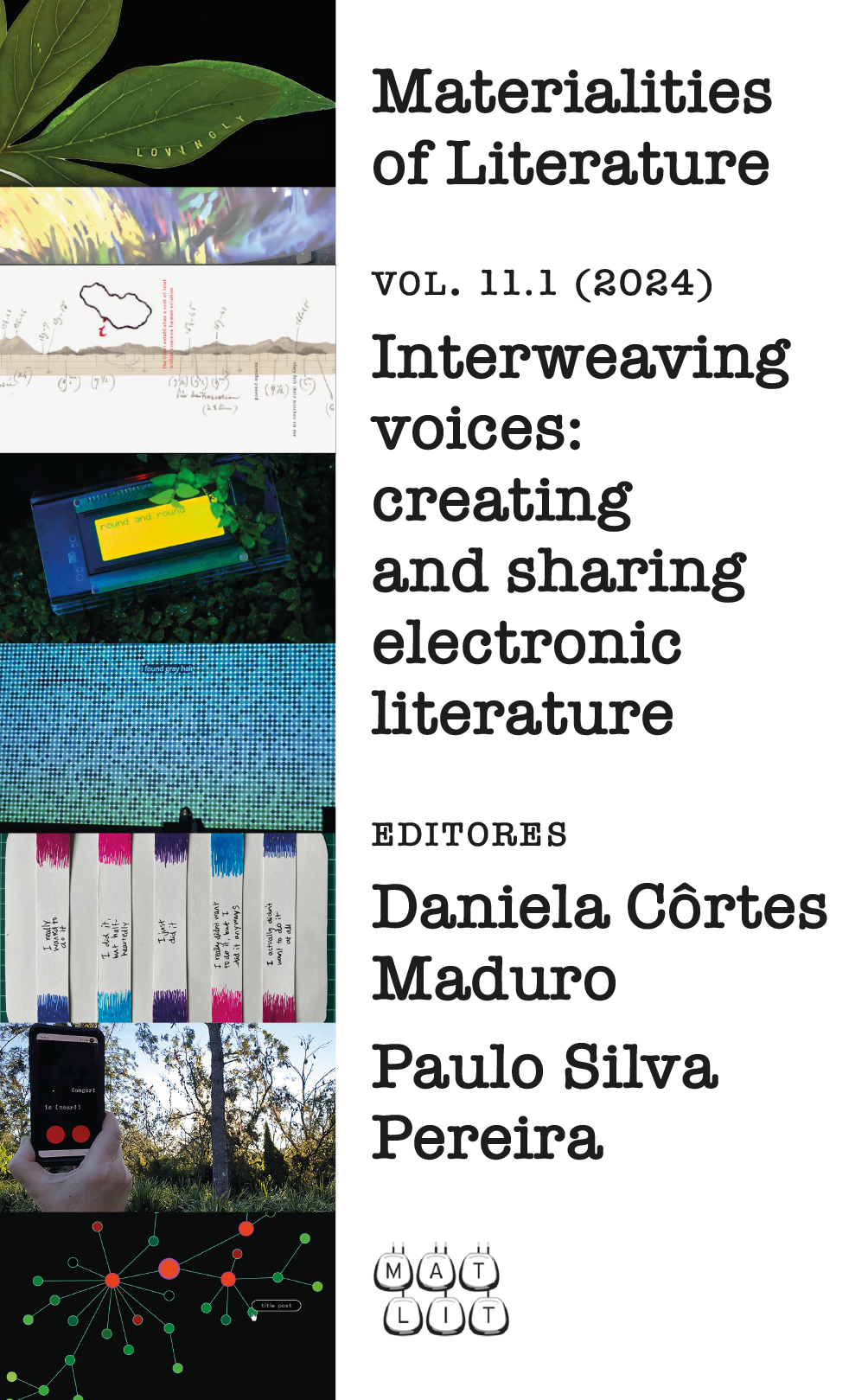Language for the Fluid, Multiple, Unified Self
DOI:
https://doi.org/10.14195/2182-8830_11-1_2Palavras-chave:
linguagem não-violenta, mestiçagem, menaing-making processResumo
Este é o texto de um discurso de abertura proferido online na Electronic Literature Organization Conference 2023, Overcoming Divides: Electronic Literature and Social Change, organizada pela Universidade de Coimbra e realizada em diferentes locais em Coimbra, Portugal e online, de 12 a 15 de julho de 2023. Esta palestra é sobre a forma como uso a minha prática artística para procurar uma linguagem não-violenta. Talvez seja mais correto dizer "criar" linguagem não-violenta, porque acredito que esta é uma prática. Estou a tentar gerar situações em que as pessoas possam usar a linguagem de novas maneiras, criar seus próprios significados e fazer com que sejam ouvidas. Nesta palestra, vou partilhar com vocês parte do que estou a trabalhar atualmente, bem como projetos passados. Vou atribuir alguns antecedentes à minha pesquisa artística, sugerir algumas características que imagino pertencerem a essa linguagem não-violenta e apresentar diferentes projetos em que investigo essas mesmas características.
Downloads
Referências
GARCIA, Ofelía (2007). “Foreword.” Disinventing and Reconstituting Languages, edited by Sinfree Makoni and Alastair Pennycook. Clevedon: Multilingual Matters.
GLISSANT, Édouard (1997). Poetics of Relation. Trans. Betsy Wing. Ann Arbor: University of Michigan Press.
HANAFI, Amira (2009). Minced English. Chicago: AHA Books.
HANAFI, Amira (2018). A dictionary of the revolution. https://qamosalthawra.com/en. Accessed 26 October 2023.
OTHEGUY, Ricardo, Ofelia García, and Wallis Reid (2015). “Clarifying translanguaging and
deconstructing named languages: A perspective from linguistics.” Applied Linguistics Review 6, no. 3: 281–307.
OXFORD ENGLISH DICTIONARY. “Information.” https://www.oed.com/information/updates/previous-updates/2000-2/. Accessed 26 October 2023.
YNGVE, V. (1996) From Grammar to Science: New Foundations for General Linguistics.
Amsterdam: John Benjamins.
##submission.downloads##
Publicado
Como Citar
Edição
Secção
Licença
Direitos de Autor (c) 2025 Amira Hanafi

Este trabalho encontra-se publicado com a Licença Internacional Creative Commons Atribuição 4.0.
MATLIT oferece acesso aberto integral a todos os números. Os autores que publicam nesta revista concordam com os princípios seguintes:
- Os autores mantêm a posse do copyright e concedem à revista o direito de fazer a primeira publicação do seu trabalho nos termos de uma licença Creative Commons Attribution 4.0 International (CC BY 4.0), que permite a terceiros partilharem o trabalho com a condição de atribuição de autoria e de referência à publicação inicial nesta revista.
- Os autores podem fazer contratos adicionais para a distribuição não-exclusiva da versão do trabalho publicada pela revista (por exemplo, publicá-la num repositório institucional ou num livro), com a condição de referirem a publicação inicial nesta revista.
- É permitido aos autores publicarem o seu trabalho em linha (por exemplo, em repositórios institucionais ou no seu próprio sítio web) antes e durante o processo de arbitragem, já que isso proporciona interações produtivas, assim como a possibilidade de citações mais cedo e em maior quantidade do artigo publicado (Ver The Effect of Open Access).
- Uma licença CC em formato legível por máquina encontra-se inserida em todos os artigos publicados pela MATLIT.
MATLIT embraces online publishing and open access to all issues. Authors who publish with this journal agree to the following terms:
- Authors retain copyright and grant the journal right of first publication with the work simultaneously licensed under a Creative Commons Attribution 4.0 International (CC BY 4.0), that allows others to share the work with an acknowledgement of the work's authorship and initial publication in this journal.
- Authors are able to enter into separate, additional contractual arrangements for the non-exclusive distribution of the journal's published version of the work (e.g., post it to an institutional repository or publish it in a book), with an acknowledgement of its initial publication in this journal.
- Authors are permitted and encouraged to post their work online (e.g., in institutional repositories or on their website) prior to and during the submission process, as it can lead to productive exchanges, as well as earlier and greater citation of published work (See The Effect of Open Access).
- A CC licensing information in a machine-readable format is embedded in all articles published by MATLIT.
- Attribution — You must give appropriate credit, provide a link to the license, and indicate if changes were made. You may do so in any reasonable manner, but not in any way that suggests the licensor endorses you or your use.
- No additional restrictions — You may not apply legal terms or technological measures that legally restrict others from doing anything the license permits.
Notices:
- You do not have to comply with the license for elements of the material in the public domain or where your use is permitted by an applicable exception or limitation.
- No warranties are given. The license may not give you all of the permissions necessary for your intended use. For example, other rights such as publicity, privacy, or moral rights may limit how you use the material.




